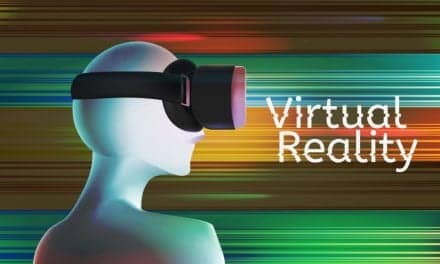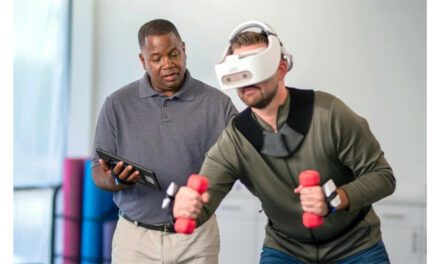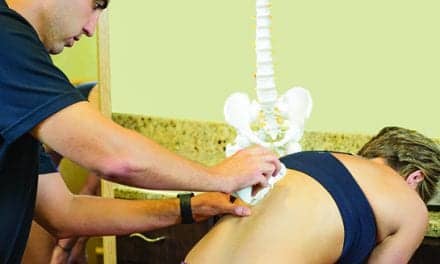Versatile technology focused on lower-extremity rehab is at the heart of a protocol that aims to return amputees to independent ambulation quickly and safely
By Jacquelin Shadle, MPT, and Emily Graham, SPT
Physical therapists are tested daily in all different settings to reach what is most patients’ common goal: to walk. One thing is consistently lacking in these environments, however: the ability to challenge someone at their highest potential while assuring safety and prevention of falls or injury. This can be exceptionally difficult when working with patients who are void of any type of proprioceptive or kinesthetic awareness at their knee, ankle, and/or foot because of an amputation.
Baton Rouge Rehabilitation Hospital (BRRH), located in Baton Rouge, La, has served as an institute for rehabilitation for the past 30 years, treating patients who are affected by a gait and balance deficiency as the result of spinal cord injury, neurological conditions, orthopedic injuries, amputations, and a variety of other causes. The primary goal of the rehab staff at BRRH is to assist patients in improving function and regaining the maximum amount of independence possible. Amputees face a number of challenges in recovering gait and balance, and one of the primary focuses of this facility is to leverage technology to overcome these obstacles.
Amputations can result from a variety of issues, ranging from vascular disease, diabetes, peripheral arterial disease, trauma, infection, and cancer. Therefore, this patient population tends to present with additional medical concerns. Taking these factors into consideration along with the psychological implications and adjustments of losing part of one’s body presents a multifaceted challenge for some.
To accommodate the needs for this patient population, the rehab team began looking for equipment that could aid in overcoming the obstacles of fear while allowing both the patient and therapists to work in a “free” environment and return patients to
independent ambulation more quickly. After evaluating the marketplace, the functions and features of the ZeroG from Aretech LLC, Ashburn, Va, seemed to be the best fit for BRRH. The ZeroG offers two different options of static body weight support (BWS) or dynamic body weight support that can be used overground, in a static state, or with a unique split belt treadmill.
The technology is able to store a patient’s clinical gait parameters through the use of an advanced interface system, and its control devices (iPod Touch or iPad) are portable and able to communicate with the home system through a wireless connection. These instruments allow therapists to monitor and track levels of body weight support, distance walked, fall settings, and training duration.
Technology Benefits
Body weight support systems are available from several manufacturers, and include products such as the Vector, available from Valencia, Calif-based Bioness, and Solo-Step, offered by Sioux Falls, SD-headquartered Solo-Step. Two other BWS products on the market include the Lokomat from Hocoma Inc USA, based in Norwell, Mass, and the SafeGait from Gorbel Medical, Fishers, NY. Though these products are offered to the market with a set of features and benefits specific to each manufacturer’s device, a common benefit provided by this group of technologies is that they reduce the number of therapists or other individuals needed to help balance the patient and prevent falls. Because of the level of safety provided—typically via a harness worn by the patient—therapists are able to step away from the patient to gain a holistic view of the patient’s gait, thus preventing “tunnel vision” on a specific deviation without fear of an incident.
While in use at BRRH, staff members have observed that the safety the ZeroG provides helps the patient as well as the therapist feel more confident, resulting in a more relaxed and comfortable treatment environment. The security the device offers may prevent compensatory strategies from developing, and the body weight support allows for partial compensation of weakness, spasticity, and abnormal coordination with any diagnosis. This allows for subjects to begin practicing early after neurological and traumatic injuries at higher intensity levels, which is related to enhanced outcomes.
Split Belt Treadmill Training
The split belt treadmill is a key feature in normalizing a patient’s gait in order for patients to return to independent ambulation. This locomotion therapy tool provides variable speed control of each leg independently, which can accommodate patients with asymmetric walking patterns regardless of cause. This feature allows the therapist to slow down advancement on the desired limb, and break down each phase of gait while continuing a fluid motion.
This technology, which is available from Woodway USA Inc, Waukesha, Wis, becomes especially helpful when working with patients with amputations or who are affected by hemiparesis. With the ability to decrease the speed on the amputated or affected limb, the therapist is able to force a patient to spend more time on that limb with the goal to decrease amputee or neurologically related antalgic gait.
In the event a patient has foot drop due to a central nervous system injury, BRRH has also had success incorporating the Bioness L300, manufactured by Bioness, Valencia, Calif, or the WalkAide from the Austin, Texas-based Innovative Neurotronics. Both of these systems use electrical stimulation to facilitate foot lift during the swing phase of gait. Through treatment with this equipment, especially coupled with a BWS to maintain safety, our therapists have been able to retrain patients and considerably improve timing and efficiency of gait.
Balance and Functional Training
While transfers, balance, and gait can all be improved with the use of a BWS and its added safety features, incorporating this type of device with other technologies has helped accelerate patients’ progress even more so. Patients are able to work on balance activities, both in a free environment or with use of a device such as the Biodex Balance System SD from Biodex Medical Systems Inc, headquartered in Shirley, NY, which allows assessments and training measures in both static and dynamic formats. Kinesthetic abilities can be enhanced and neuromuscular control can be quantified while assessing dynamic bilateral and unilateral postural stability with any one of the 12 levels of platform control. Objective documentation can be produced with the color-printed reports to track progress and assist with reimbursement. Using a BWS in a static position along with the Biodex Balance System SD has helped patients initially trust their abilities with the activities, knowing they are in a safe environment and will not fall.
Overground training is also an essential element of a functional and gait training program for all types of patients. Gait training is performed in a realistic manner, allowing for use of adaptive equipment when needed to assist transitioning to independent ambulation. Also, patients are able to train on higher-level tasks, such as curbs, ramps, uneven terrain, and stairs, much earlier.
With the use of a BWS, new amputees are given opportunities that they would not usually experience. For example, a new amputee may begin ambulation much more quickly because that person will be able to bear a determined amount of weight through the residual limb(s). This feature allows for providing residual limb protection in the early phases of rehabilitation and gait training, which is not possible without using reduced body weight technology.
Pairing the overground option of certain BWS devices with SmartStep by Andante Medical Devices Inc, White Plains, NY, is another way to monitor targeted weight-bearing goals. By use of the SmartStep force-sensing insole, patients can either be trained to put limited weight through the extremity after orthopedic insult or surgery, or it can provide feedback letting them know when they are putting adequate weight through the foot when trying to correct antalgia or neurological retraining.
The system’s control unit relays data from both the heel and forefoot to a computer running the SmartStep software, including weight-bearing, velocity, cadence, and movement timing. There is also an interactive training option to help increase patient motivation and performance. Once the patient’s balance and fall risk are under control, these systems can be utilized without a BWS.
Another option for gait training is the Solo-Step system, which is a weight-bearing, fall-prevention physical therapy device that is designed to provide a safe atmosphere for balance and gait training. The system allows for natural range of motion and reduces the fear of falling for the patient during therapy, and the system promotes faster rehabilitation and return to full strength.
The LokomatPro also is designed to enable patients to improve overground walking by means of a body weight-supported robotic gait orthosis and treadmill. The Lokomat also offers a pediatric orthoses, which is an add-on module designed to provide locomotion therapy for young children.
Patient Satisfaction
The use of these technologies has been exponentially helpful with improving gait and the overall rehabilitation of patients at BRRH. These patients are able to walk sooner, walk farther, and demonstrate increased endurance, with the decreased fear of injury for both the patient and the therapist. The use of BWS helps patients accomplish success much more quickly, therefore resulting in more highly motivated patients and increased satisfaction for everyone.
The staff at BRRH has been able to apply the variety of features these technologies have to offer to a multitude of patients with varying diagnoses. Patients are able to work on static and dynamic balance, transfers, ADLs, pre-gait activities, gait, and high-level tasks, such as curbs, ramps, and stairs. Not only does the staff love the benefits, but so do the patients. PTP





